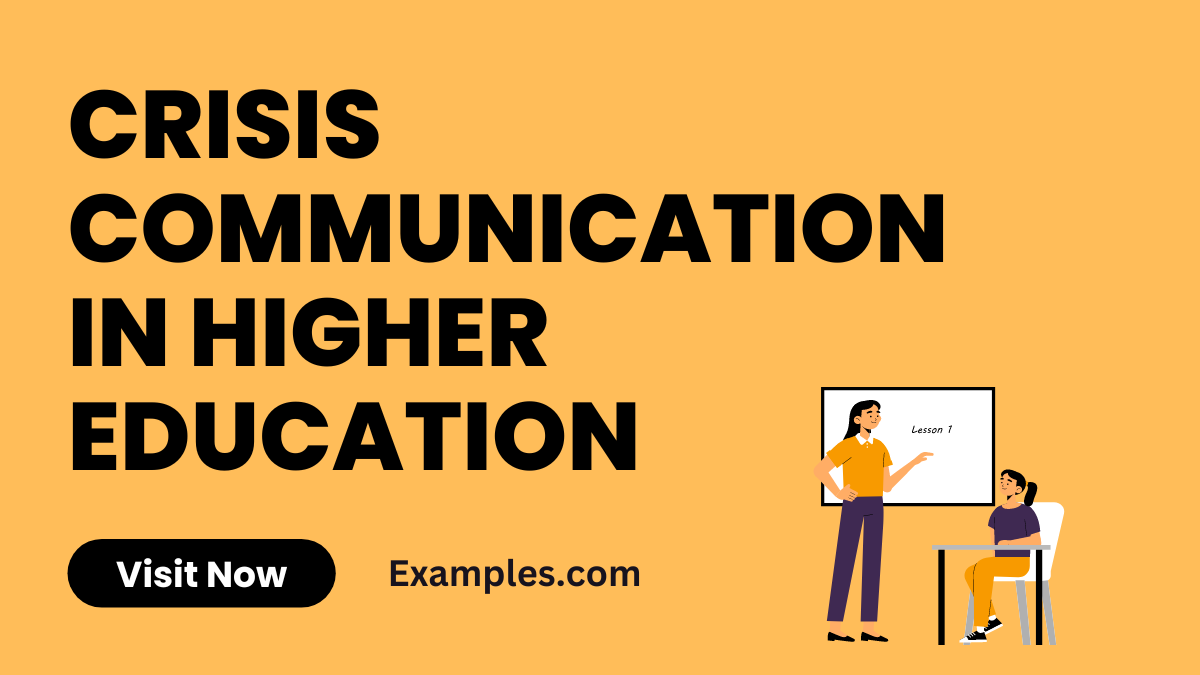19+ Crisis Communication in Higher Education Examples
Embark on a journey through Crisis Communication in Higher Education with this comprehensive guide. Uncover essential strategies, valuable tips, and real-life Communication Examples to navigate challenges in the academic realm. From effective crisis management to fostering resilience, this guide equips you with the tools needed to ensure a robust and well-informed higher education community. Explore the dynamic intersection of crisis communication and academia for a more secure educational environment.
What is Crisis Communication in Higher Education?
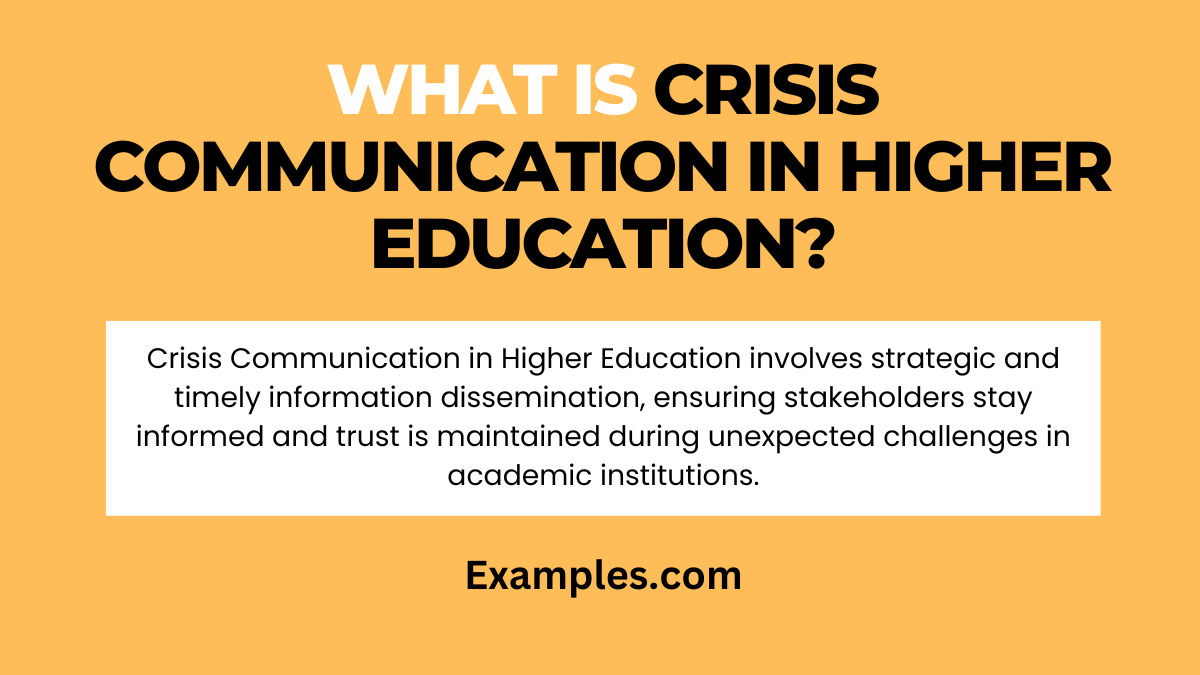
Crisis Communication in Higher Education refers to the strategic and deliberate process of managing and disseminating information during unexpected events or challenges in academic institutions. In simpler terms, it involves clear and timely communication to address uncertainties, ensuring stakeholders stay informed, trust is maintained, and the higher education community remains resilient in the face of unexpected situations. This approach is crucial for safeguarding the reputation and stability of educational institutions during crises.
What is the Best Example of Crisis Communication in Higher Education?
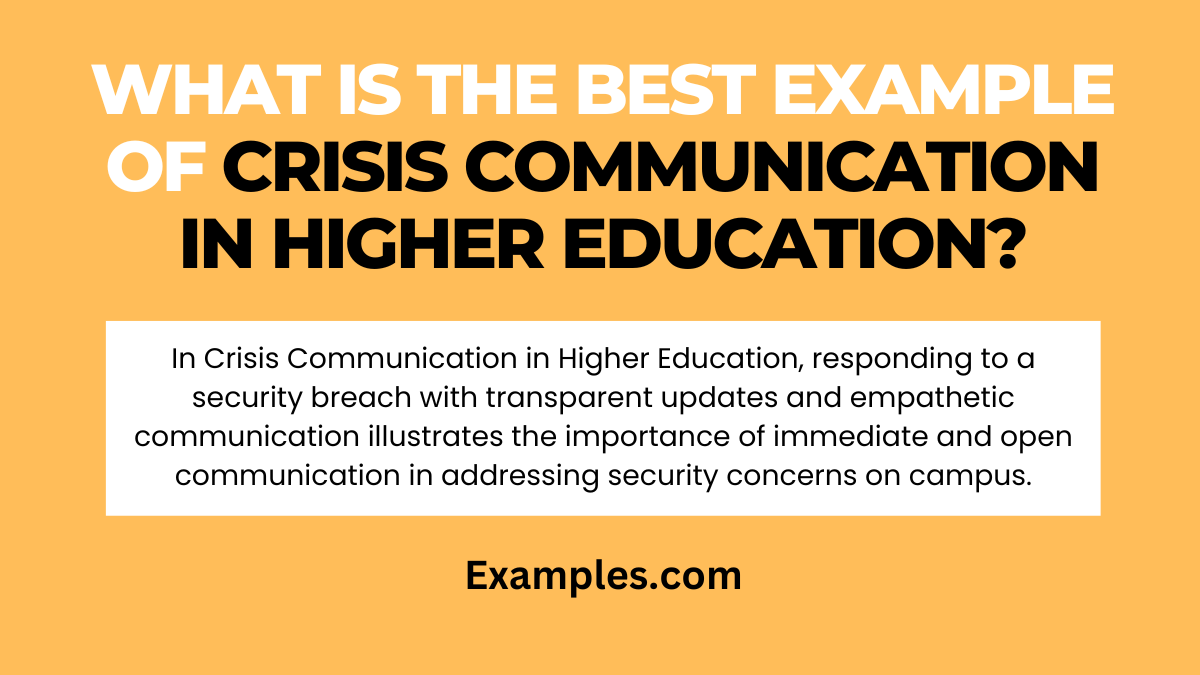
One notable example of Crisis Communication in Higher Education is the response to a campus-wide security breach. The institution promptly communicated the incident to students, faculty, and staff, providing transparent updates on the situation. The crisis team implemented safety measures, offered support services, and maintained open lines of communication throughout. This case illustrates the significance of immediate, transparent, and empathetic communication in addressing security concerns within higher education institutions.
20 Crisis Communication in Higher Education Examples
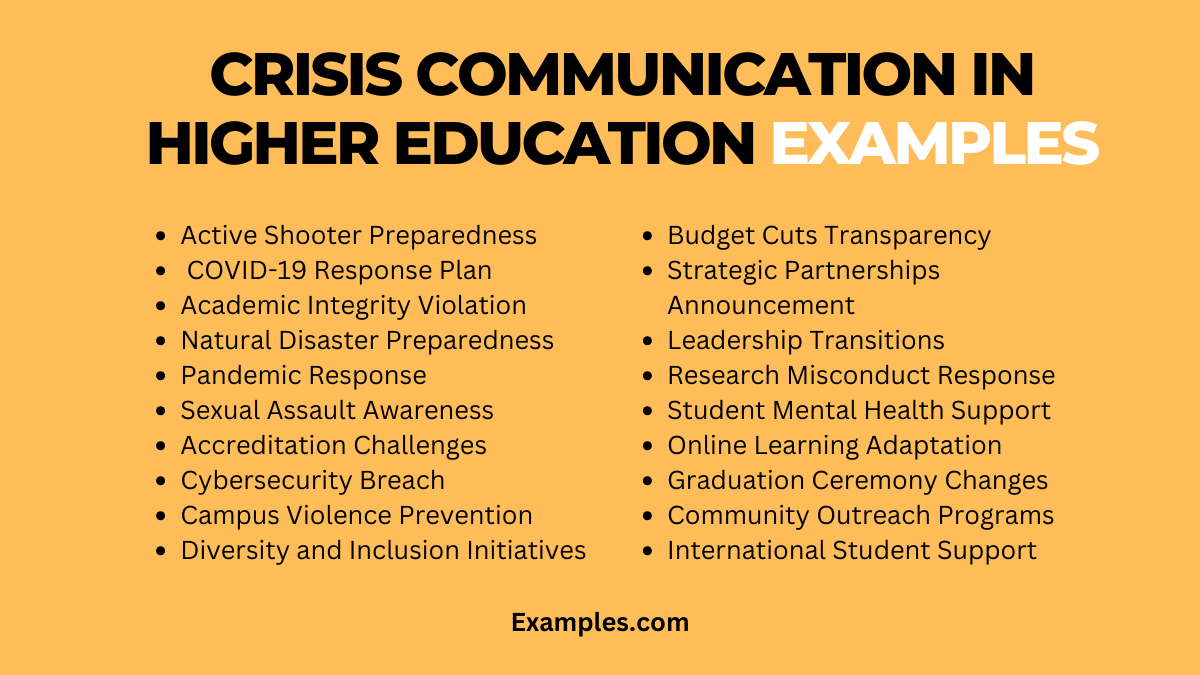
Crisis Communication in Higher Education is crucial for maintaining transparency and trust. Explore unique examples showcasing strategic responses to unexpected challenges.
- Active Shooter Preparedness
- Proactive communication about drills, security measures, and support resources assures the campus community of safety commitment.
- COVID-19 Response Plan
- Transparent communication on safety protocols, testing strategies, and vaccination initiatives ensures a well-informed and protected campus.
- Academic Integrity Violation
- Clear communication on policies, consequences, and preventive measures maintains trust in academic standards.
- Natural Disaster Preparedness
- Detailed communication plans, evacuation procedures, and post-disaster support demonstrate a commitment to student safety.
- Pandemic Response
- Clear communication on health protocols, remote learning strategies, and support services during a pandemic builds confidence in institutional management.
- Sexual Assault Awareness
- Transparent reporting mechanisms, awareness campaigns, and support services exemplify dedication to a safe campus environment.
- Accreditation Challenges
- Communicating efforts to address accreditation issues demonstrates commitment to maintaining academic standards.
- Cybersecurity Breach
- Prompt disclosure and communication on cybersecurity breaches assure stakeholders of proactive measures and data protection.
- Campus Violence Prevention
- Communication on preventive measures, reporting procedures, and counseling resources addresses concerns about campus safety.
- Diversity and Inclusion Initiatives
- Highlighting inclusivity efforts and progress fosters positive community relations and showcases commitment to diversity.
- Budget Cuts Transparency
- Openly communicating budget constraints, decision-making processes, and impact assessments minimizes uncertainty during financial challenges.
- Strategic Partnerships Announcement
- Communicating collaborations with external organizations enhances the institution’s reputation and provides potential benefits.
- Leadership Transitions
- Transparent communication during leadership changes, outlining plans and expectations, helps maintain stability.
- Research Misconduct Response
- Addressing research misconduct transparently, with corrective actions and preventive measures, upholds academic integrity.
- Student Mental Health Support
- Communicating available mental health resources and initiatives destigmatizes seeking help and promotes student well-being.
- Online Learning Adaptation
- Clear communication on the transition to online learning, technological support, and expectations facilitates a smooth shift.
- Graduation Ceremony Changes
- Transparently communicating changes to graduation ceremonies ensures graduates and families are well-informed and involved.
- Community Outreach Programs
- Sharing details of community outreach programs strengthens ties with local communities and showcases social responsibility.
- International Student Support
- Transparently communicating support measures for international students during crises fosters a sense of belonging.
- Research Funding Challenges
- Openly addressing challenges in research funding, along with strategies for sustainability, maintains credibility and support from stakeholders.
Crisis Communication in Higher Education for Students Examples
Effective communication in higher education during crises is paramount to student well-being and success. Here are five examples illustrating best practices:
- Remote Learning Transition
- Example: Informing students about the shift to remote learning, providing clear guidelines and technical support for a smooth transition.
- Mental Health Resources
- Example: Communicating available mental health resources, including counseling services and virtual support groups, to address the emotional impact of crises.
- Campus Safety Updates
- Example: Sharing real-time safety updates, such as campus closures or emergency procedures, to keep students informed and secure.
- Financial Aid Guidance
- Example: Communicating changes in financial aid policies, offering guidance on application processes, and addressing concerns during economic uncertainties.
- Community Engagement Initiatives
- Example: Involving students in community engagement initiatives, fostering a sense of connection and shared responsibility during challenging times.
Crisis Communication in Higher Education for Elementary Teachers Examples
For elementary teachers navigating crises, effective communication is key to maintaining a supportive learning environment. Here are five examples:
- Virtual Learning Expectations
- Example: Communicating clear expectations for virtual learning, outlining schedules, platforms, and interactive elements to ensure a smooth transition for both teachers and students.
- Emergency Preparedness
- Example: Sharing emergency preparedness plans, including evacuation procedures and communication protocols, to enhance teacher confidence and ensure student safety.
- Parent-Teacher Collaboration
- Example: Facilitating regular communication with parents through virtual meetings, newsletters, and collaborative platforms to address concerns and provide academic updates.
- Adaptive Teaching Strategies
- Example: Adapting teaching strategies to accommodate diverse learning needs, offering resources and support for differentiated instruction during crises.
- Resilience and Well-being Programs
- Example: Introducing programs focused on teacher well-being and resilience, including mindfulness sessions and peer support networks, to enhance overall morale during challenging times.
What is the Importance of Crisis Communication in Higher Education?
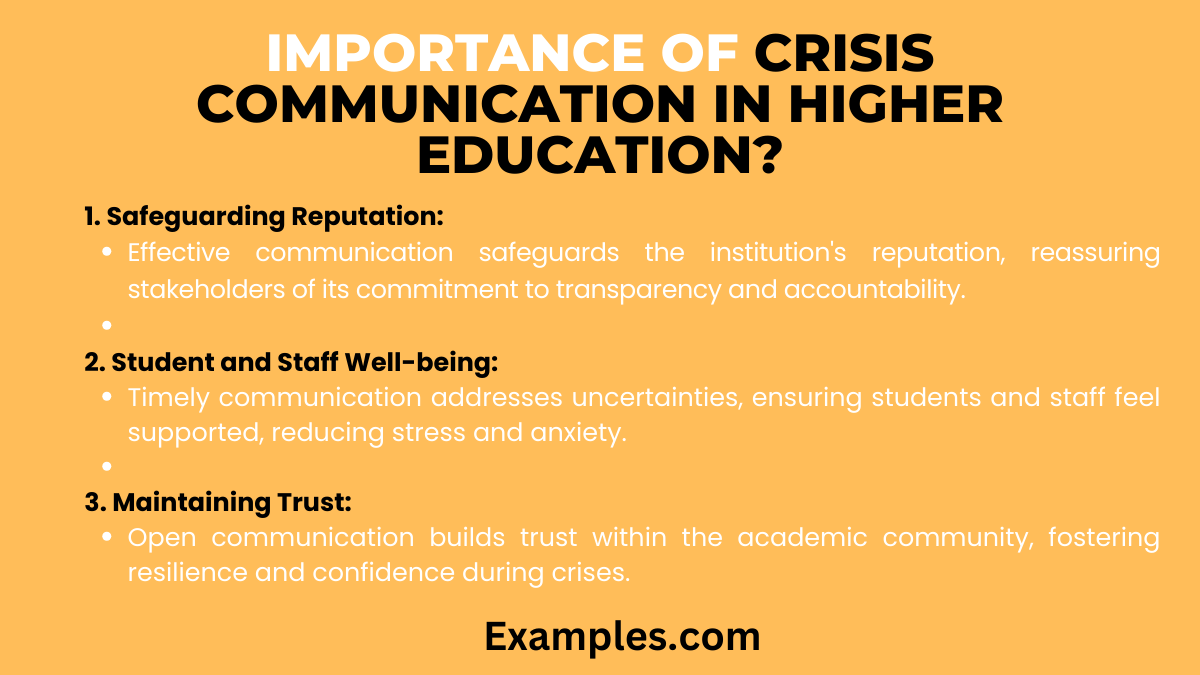
Crisis communication in higher education is crucial for maintaining stability, trust, and student well-being during challenging times. Here’s why it matters:
- Safeguarding Reputation: Effective communication safeguards the institution’s reputation, reassuring stakeholders of its commitment to transparency and accountability.
- Student and Staff Well-being: Timely communication addresses uncertainties, ensuring students and staff feel supported, reducing stress and anxiety.
- Maintaining Trust: Open communication builds trust within the academic community, fostering resilience and confidence during crises.
- Community Perception: Well-handled crisis communication positively influences how the broader community perceives the institution, mitigating potential negative impacts.
- Operational Continuity: Clear communication strategies facilitate operational continuity, allowing for efficient decision-making and adaptation to unforeseen challenges.
How to improve the strategy of Crisis Communication in Higher Education?
Enhancing crisis communication strategies in higher education involves adopting proactive measures and refining existing processes. Here’s how:
- Regular Training Programs:
- Conduct regular training programs for staff to ensure they are well-prepared to communicate effectively during crises.
- Developing Clear Protocols:
- Establish clear communication protocols, outlining responsibilities and channels for disseminating information during different crisis scenarios.
- Utilizing Technology:
- Embrace technological tools for rapid and widespread communication, such as automated notifications, social media, and dedicated crisis communication platforms.
- Engaging Stakeholders:
- Actively engage with students, staff, parents, and the community to understand concerns and tailor communication strategies accordingly.
- Scenario Planning:
- Conduct scenario planning exercises to anticipate potential crises, allowing the institution to develop pre-approved communication responses.
- Transparency and Authenticity:
- Prioritize transparency and authenticity in communication, acknowledging challenges, and providing honest updates to build trust.
- Feedback Mechanisms:
- Establish feedback mechanisms to gather input on the effectiveness of crisis communication, enabling continuous improvement.
- Collaboration with Experts:
- Collaborate with communication experts and crisis management professionals to refine strategies and stay informed about best practices.
Tips for Effective Crisis Communication in Higher Education?
Navigating crises in higher education requires a strategic and empathetic approach to communication. Here are concise tips for ensuring effective crisis communication in the higher education sector:
- Immediate Communication
- Communicate swiftly to keep students, faculty, and staff informed about the situation.
- Clarity and Transparency
- Provide clear and transparent information to avoid confusion and address uncertainties.
- Utilize Multiple Channels
- Disseminate information through various channels, including email, official websites, and social media, to reach a wider audience.
- Engage Stakeholders
- Involve key stakeholders, such as students, parents, and faculty, in decision-making processes to foster a sense of community and shared responsibility.
- Personalized Support
- Offer personalized support services, acknowledging the diverse needs and challenges faced by individuals during crises.
- Regular Updates
- Provide regular updates to keep the community informed about the evolving situation and any changes in protocols.
- Address Mental Health
- Prioritize mental health communication, offering resources, counseling services, and promoting a supportive environment.
- Training and Preparedness
- Conduct crisis communication training for faculty and staff to ensure a coordinated and well-prepared response.
- Responsive Feedback Mechanism
- Establish a responsive feedback mechanism to address concerns, gather insights, and adjust communication strategies accordingly.
- Collaborate with External Partners
- Collaborate with external agencies, local authorities, and other educational institutions to enhance collective crisis response capabilities.
Implementing these tips fosters an environment of resilience, trust, and collaboration within higher education institutions during challenging times.
In conclusion, effective crisis communication is the bedrock of stability in higher education. Swift, transparent, and empathetic communication ensures a cohesive response to challenges. Real-world examples illustrate the importance of strategic communication, guiding institutions towards resilience. This comprehensive guide empowers higher education professionals to navigate crises successfully, fostering trust and maintaining the integrity of academic communities.



